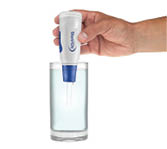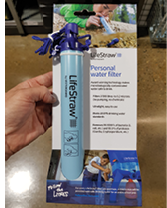

Staying Hydrated on Bushwalks
Sonya Muhlsimmer



We are now clearly in the hotter months of the year - sigh, bring back winter - and one of the most important things to consider out on the trails is keeping hydrated. Every year there are numerous cases of bushwalkers suffering dehydration and needing rescuing, and unfortunately too many dehydration cases have resulted in death. That is why it is important to keep yourself hydrated. Dehydration is avoidable and is generally caused by either a lack of knowledge and/or being ill-prepared. So let’s get prepared so you don’t become dehydrated out on the trail and at worst case, a statistic.
After a climb from Square Lake, Western Arthur Ranges, Tasmania, it was time to have some food and waterPaul Every
48 | BWA December 2018
Water in the bodyWater makes up to about 50-70% of the body’s weight, a huge amount.
Blood is about 90% water.
Muscles are about 75% water.
Bones are about 25% water.
Water loss up to 3% can decrease the blood volume – this means less oxygen can travel trough the body, less blood gets pumped through the heart and the body temperature can raise a lot quicker. A 5% loss causes disorientation and confusion and a 10-20% loss of water can be fatal. You can lose 2-3 litres a day of water by sweating, going to the toilet and also by breathing, and in worst cases you lose a lot of water when you are sick and are throwing up or are suffering from diarrhoea. It is not only water that you lose; it is the electrolytes and sodium which are contained in the cells that can be lost. These electrolytes are important as they regulate nerve and muscle functions and need to be replaced.
DehydrationSome symptoms of dehydration include:
Having a dry mouth,
Feeling thirsty,
Dry skin,
Suffering a headache,
Not needing to pee much and when you do pee your pee is a dark yellow colour, (check the table below),
Lack of energy,
Loss of appetite,
Rapid heartbeat, and
Feeling dizzy or even fainting.
This chart can help determine how hydrated you are (chart taken from dripdrop.com). Check it out.
What colour?
Are you hydrated?
Pale yellow to clear is normal and indicates that you are well hydrated.
Light yellow and transparent is also normal and indicates an ideal hydration status.
A pale honey, transparent colour indicates normal hydration, but may mean that you need to hydrate soon.
A yellow, more cloudy colour means your body needs water.
A darker yellow, amber colour isn't healthy. Your body needs water.
Orangish yellow and darker: you're severly dehydrated. Contact your doctor immediately.
Dehydration is preventable, by drinking enough water. No, not by guzzling a bottle every few hours, and I know a lot of people that do that, or worse still that they even wait until camp to rehydrate. The best way is sipping as you go. Do not wait until you are thirsty; remember this is one sign that you are already dehydrated.

“Dehydration is preventable, by drinking enough water.
BWA December 2018 | 49
Keeping rehydratedAs mentioned, I find the best way out on the trails is by sipping water, and electrolytes, regularly. This way you won’t get thirsty, won't lose a lot of electrolytes and won’t suffer dehydration.
Water bladders are great as you can sip on the go without having to take the pack off and reach for the water bottle. I also keep a bottle on the side filled with a sports drink formulation. Sports drinks are designed to replace water and electrolytes and give you a bit of energy. This gives you a choice of drinks, as sometimes water alone can be pretty boring and not sufficient enough, and the sports drink replaces the electrolytes your body loses through sweat.
There are plenty of sports drinks on the market, and they are scientifically designed so follow the instructions. Go for the one you like best or either pick the one that has the highest energy level per 100 ml content. There is a good range at the supermarkets.
Hydrolyte tables or powder sachets are also a scientific formulation and can be found at chemists. I always keep some sachets in my first aid kit; you never know when you, or someone may need a pick-me-up and besides, the sachets only weigh in at 6 grams each, and are designed to be added to 200 mL of water. I have had to help bushwalkers suffering dehydration a few times, and it is not good for them or me to be in that situation. One sachet goes a long way in treating someone with mild dehydration.
Finding safe drinking water on the trailsHow do you know if the water you find on the trail is suitable to drink? It looks clean, right, so is that good enough? Well, that
does depend a lot on where you are. Are there farms, or suburbs close by? Areas that have a lot of visitors and no toilets may also have poor water quality, such as either side of Pelion Gap in Tasmania. Most remote Tasmanian wilderness has clean, drinkable water but in some parts of Kosciuszko National Park in NSW it is advisable to treat the water as Giardia has been found. And if you are camping in the Blue Mountains, treating water with tablets and filtering the water is advisable. Do your research of the area before you head out. But if you have any doubt, I suggest treating the water. This can be done with tablets, filtering, boiling the water or even with UV light.
Tablets for disinfecting waterThere is a range of tablets on the market, but the Katadyn Micropur tablets are the ones I use. I have suffered terribly due to drinking bad water, and it is not pleasant. It doesn’t take much to treat water, just pop a tablet into the water; it may just save you a lot of pain and suffering in the end. These tablets come in a blister pack and can last a long time, just use what you need. Some other tablets come in a bottle which is heavier to use and due to the moisture in the air every time you open the jar, they don’t last as long. With treating water, the moral of the story is if in doubt, treat the water. The active ingredient in the tablets is usually chlorine, chlorine dioxide or iodine, so you may be able to taste a taint in the water, pending your sense of taste. They are


50 | BWA December 2018
designed to kill bacteria. Again the tablets are a scientific formulation so follow the instructions, oh but you have to wait at least 30 minutes for the tablets to work. It can be a good idea to carry two water bottles, one for ready to drink water - and one for water that is being treated. The other disadvantage about the tablets is, they do not remove sediments. This is where filtering can be used.
Filtering waterPump filters can be used, however they are a bit time consuming, especially if you have been allocated the job of collecting water for camp for the night. You could find yourself sitting on a river bank, pondering the day and well, um, pumping water, litres and litres of it. And it depends on what kind of pump you have as to how long it takes. I have been told the Sawyer brand pumps are good. The pumps trap most bacteria – but not viruses, that are in the water, but they come with a few parts and you have to maintain them to be any good. And some can be a bit on the heavy side. There are a few brands and sizes around at different price points so for the scope of this article I suggest you do your own research. Talk to your camping store, they will be able to suggest the best one for your needs.
You do have an option of a life straw for personal use. A life straw is a water filter that looks like a large thick straw. It uses a hollow fibre membrane and does not require chemicals and it removes 99.9 percent of waterborne bacteria and it reduces the muddines of water, so it cleans the water.. Lifestraws are small and light weight and great for minimalists, as you can just stick it in a stream and drink. Admittedly I do not own a filter pump, and I have been known to filter water through my shirt when needed, with the use of the tablets.
Boiling waterThis is great at camp, but not necessarily during the day when you’re on the move.
Boiling water will kill bacteria, viruses and anything really. Simply put a pot of water on and boil for about two minutes. If you’re at high altitudes, boil for around three minutes. For example, on higher NSW and Victorian peaks and plains the boiling point for water is around 92 °C. There's a calculator showing altitude and and boiling point.
Ultra violet Some wastewater treatment plants treat the water with UV light - and other treatments - before releasing it into the environment, so I guess that is some reassurance in the method. I must say I have not used one before, so I have just Googled this information. Steripens kill off 99.9 percent of bacteria and viruses. It does not add an additional chemical so the there is no faint taint. They are expensive, but they are light and fit in the top of a rucksack nicely, there's no bulky parts and no real maintenance required, and they are easy to use. Just pop it in the water and turn it on, presto you have clean water, and your own pocket size force beam. May the force be with you! Steripens do require batteries, so you want to ensure you take spare batteries if you use this method. I have seen tourists in the Blue Mountains on a day walk using a Steripen on water they collected from a waterfall.
Final adviceAs mentioned there are numerous cases of rescues and deaths due to dehydration, so it pays to be prepared. Do your homework for the area, including the availability and potability of water before you head out. And remember this, TREK:
T - Take adequate supplies of food, water, navigation and first aid equipment.
R - Register your planned route and tell friends and family when you expect to return.
E - Emergency beacon (PLBs) are available free of charge from NSW Police Force and NPWS.
K - Keep to your planned route and follow the map and walking trails.


SteriPEN Classic 3
Lifestraw - ultra-light “straw” water filter
BWA December 2018 | 51